In today’s crowded markets it can be difficult to differentiate your company from global competitors. Many business leaders have recognized the importance of customer experience as a means of differentiation. Creating an experience that is relevant, meaningful and delights begins with a commitment to understanding your customers. Quite often, companies don’t take the time to listen to what customers are anxious to share … what they truly Value. For successful companies, the focus on Value begins with actionable insights and remains a central thread as they look to deliver new solutions that drive market leadership and differentiation.
At flo, our Customer VALUE Framework helps companies gain an intimate understanding of their customers, exposing experience gaps that create opportunities to drive cross-functional change that is focused on delivering compelling customer Value.
Customer VALUE Framework
Delivering compelling Value…

As companies interact with customers to gain fresh insights, they need to ensure customer conversations include a focus on Value. This discovery helps companies map “Value Factors” that serve as guide posts as teams consider and prioritize new ideas and concepts. Often, companies invest in secondary research or conduct satisfaction surveys which don’t provide the vehicles for exposing these valuable insights.
Customer profiles and personas are a great way for companies to elicit customer characteristics, including what they Value. These qualitative approaches inform teams as they consider new concepts and solutions, keeping customer needs, wants and desires in view as they move new solutions through the many tradeoffs that often occur during design and delivery. Many new products and services that are intended to create an exciting new customer experience miss the mark as corporate teams get caught-up in the internal challenges of driving a new idea to market. Often, so many compromises have been made without the customer in mind that the new solutions no longer address the original Value Factors that were identified … one of the main reasons so many new offerings fail.
Have you made “Value” a focal point in your conversations with customers and within your teams? In most cases customers will not be able to tell you the new and different solutions they need, but they can tell you what they Value most in their day-to-day activities and experiences (or what they would like to see done differently to improve their experience).
A great way to become more focused on your customers and what they Value is to take the time to “askWHAT4”. As you start your day, as you begin meetings, as you think about new ideas, as you make decisions, as you design new solutions … “askWHAT4”.

Asking WHAT4 helps keep the customer top-of-mind as teams go about their day-to-day activities and will keep them focused on what customers Value. Are you asking WHAT4 … do you know what your customers Value?
Case Study
We recently worked with a company that was trying to differentiate their solutions in an industry where offerings were becoming commoditized. The leadership team realized the importance of becoming more customer-focused and forming stronger relationships with their customers.
They had rarely interacted with their customers beyond account rep. visits or the occasional customer support call. We helped them establish new vehicles for proactively interacting with customers, capturing meaningful insights that provided fresh perspectives on who their customers were and what they Valued. We implemented customer journey maps and created profiles/personas that highlighted behaviors, attitudes, aspirations and Value. We found that customers were delighted to be participating in these conversations and were happy to share what they Value most in provider relationships and industry solutions.
The company used these new insights to help inform cross-business teams as they prioritized new change initiatives aimed at delivering increased Value and more compelling customer experiences. Teams were excited to be closer to the customer. This created a whole new atmosphere and environment … the beginnings of a “Customer” culture. A number of new customer initiatives were launched that were focused on new policies, services and solutions that were designed to deliver exciting new customer experiences and Value. As teams measured the impact of some of these initial efforts, they found that both Satisfaction and Loyalty had improved … and stronger relationships had formed.



